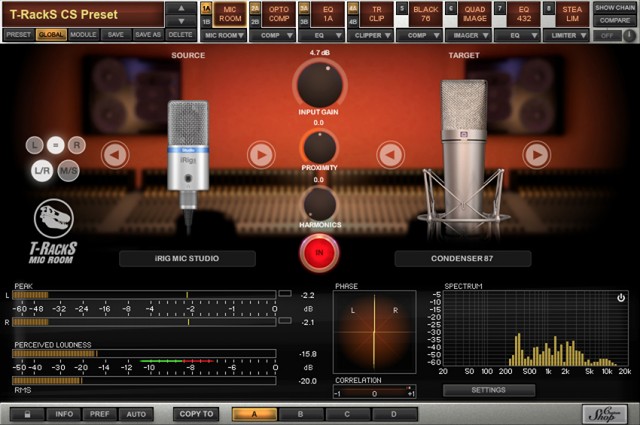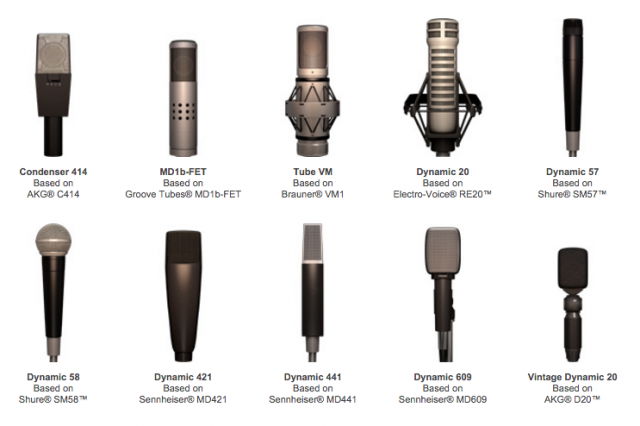
Can’t afford a vintage Neumann U67 microphone?
IK Multimedia has introduced Mic Room – a microphone-modeling app that lets you ‘re-mic’ recordings, giving you a virtual mic collection.
They’ve modeled the frequency response and characteristics of a variety of microphones, letting you record with an $100 Shure SM-58 mic and, according to IK, turn it into a recording that sounds like it was recorded with a rare, expensive mic.

Mic Room is designed to change the sonic profile of recorded audio to match the signature of the chosen microphone. It’s designed to be placed on individual tracks that contain recorded audio from a microphone source, like vocals, acoustic guitars, miked electric guitar amps or drum tracks.
Here’s a video intro:
Once placed on the track, T-RackS Mic Room lets you choose the “source” microphone that was used to capture the original audio, from a list of all the available models. You can then choose a new microphone to re-mic the character of your original recording to match the specific nuance, color and tonal character of the modeled microphone.
T-RackS Mic Room also offers some extra tone control features that allow an even greater amount of sonic customization.
- The proximity control lets you emulate the proximity effect that naturally occurs when a source is near a microphone. Using this control, you can make it sound like you’re right next to the mic, for a rich and bassy sound. Or, you can digitally ‘scoop out’ the low frequencies for a completely different sound.
- The harmonic content adjustment effect provides control over the harmonic complexity of a modeled tube condenser. It adds a kind of saturation, texture and warmth that IK says works especially well for ‘adding zing to lackluster vocal tracks’.
Pricing and Availability:
Mic Room is available now for US $69.99. Mic Room is also available for iPhone, iPad and iPod touch. Additional microphone models are available via in-app purchases.
If you’ve used Mic Room, leave a comment and share your thoughts on it!

Neat.
This will work wonders for my Radio Shack mike.
Did they buy the Antares Microphone Modeller? :p
That was a very nice tool. I especially loved the proximity control feature.
Yeah, sure. And Santa is A REAL PERSON.
nice now i can sell all those pricy microphones
Question:
How does the modeling software compensate for different mic pres that your source mic is plugged into? Doesn’t that affect impedence, freq response, slew, etc???
Wonder how this compares to the Slate VMR
It doesn’t. It’s horse shit.
Would be great if it could turn my U67 into a SM58!!
At last – a cheaper way to sound exactly like everybody else. I bet it won’t do my 1950s carbon mic or even my Ardente Labs 1930s research microphone.
MirlitronOne
Click through to their site – they’ve actually got a carbon mic model!
I less interested in the idea that you can simulate expensive mics than the idea that you could use this creatively.
In all likelihood, these either use some kind of impulse response technology, or EQ profile matching. They take a “response” snapshot of the source mic (i.e., it’s spectral curve), and then a second snapshot of destination mic. I imagine it is a two-stage process that first applies some kind of “neutralizing” step using the source profile, to get it to basically a flat, zero signal, then applies the destination profile to adapt that signal to the destination mic sound.
Obviously, this plug-in can’t restore what is lost by the source mic. However, I would be curious if it can do things to attack transients to re-shape them somehow. I don’t imagine it will do anything about noise in the signal from a cheaper mic, either.
I think IK’s was the first to provide the Apple built-in mic as a source. Which has been a missed opportunity in so many iOS apps.
Yet another glorified EQ…
Does anybody remember ‘Mic Modeler’ by Antares? – this didn’t work out well there, way back when…
“Yet another glorified EQ…”
Kind of like amp modeling and convolution reverbs are glorified EQ.
It looks like IK is taking fairly well established pro technology and turning it into a mainstream tool. This is what’s happened with convolution, amp modeling, tuning plugins, etc in the last decade.
For some perspective on mic modeling and its pros and cons, check out this SOS review of Antares from 15 years ago:
http://www.soundonsound.com/sos/apr00/articles/antares.htm
They said that mic modeling “will get you close enough that nobody will notice”.
Obviously – the tech has improved in the last 15 years.
Sound on Sound is good for learning specific details about a product but I wouldn’t take their opinion on any piece of gear very seriously. They give glowing reviews of EVERYTHING.
I’d disagree – they consistently have the most thorough reviews around. They don’t review a lot of garbage products, though, because their audience is professionals.
I am disappointed to see this being posted this way by Synthopia. Credibility has taken a hit.
I completely disagree. I don’t see any problem with this being posted here.
I’m not a big fan of IK, generally, as their products usually don’t live up to the hype. Also, on this site, I think any marketing hype whether of hardware or software, analog or digital, should be taken with a grain of salt; but why not post a release of a mic emulation plug-in?
FWIW, it would be much cheaper to buy the iPad version (assuming you already have an iPad); and use one of the audio streaming options (like Secret Base’s Music i/o) to port audio between your desktop DAW and your iPad. I think for under $20 you get the full version and all mics. It’s much less if you just order a few mics you like at $2 a pop. With the iPad version it would be one track at a time, though. Otherwise, I don’t know how the feature sets compare.
Mike
Where’s the beef? How is this different than using a virtual analog, an amp modeler, physical modeling or convolution reverb?
They all give us access to tools that most of us would not otherwise have – whether it’s a CS-80, a Taj Majal to record in, or like MirlitronOne suggested above, a vintage mic.
Nobody thinks that these are perfect replacements for the real thing – but they are useful and cost-effective ones. And, because they’re virtual, many of these virtual tools can be used to do things that would be impossible with physical alternatives.
Yes, it is horrible to see them posting about something that emulates something else in the physical realm as its initial/core intent and which can also be used in creative ways beyond that to achieve interesting sounds. Unlike being a SYNTHesizer uTOPIA or something… oh wait…
Edit – I see Jert covered this above
I’m sceptical of course, but until I try and use it I won’t rule it out. If you started with a decent source mic it could probably be pretty useful. Needless to say some of the comments on here and Facebook are pretty funny and I’m glad Synthtopia posted it, It certainly interested me enough to click through and watch the video.
They should have called this “IK TURD POLISH”.
And we all know how well that tends to end!
You shouldn’t be so hard on your source material, calling it something like that. Whatever the case, though, you can try it for free for 14 days to see if it will polish (or unpolish) your source material in a pleasing way: http://www.ikmultimedia.com/trmicroom or just get T-RackS Custom Shop and try it http://www.t-racks.com/cs
Give me a reasonable discount and I might contemplate it 😉
Classy come back!
Thanks for taking the time to respond to reader feedback. I know our readers appreciate it!
In the demo vid I saw, the guy changed the sound of 58s used as overheads into the sound of some classy mic..it was impressive…but then I remembered I had Waves C6 so I miced a cymbal using a 58 as O/H and with one small tweak on the C6 cymbal setting the sound was identical…I’m not saying this would work on every instance but it made me think twice about buying it.